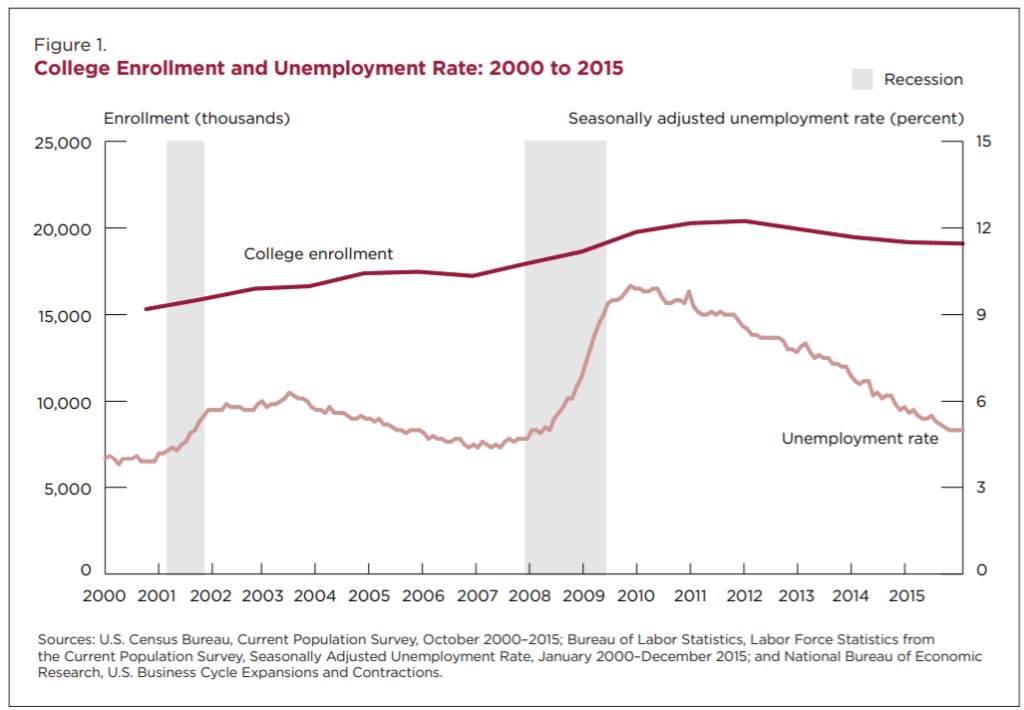enrollment
Graduate and Online Enrollment Marketing in the New Normal
By now, you’ve likely tackled immediate needs for addressing how COVID-19 has begun to affect your enrollment marketing plan, but what’s next? This massive disruption has caused us to pivot, rethink our priorities, and start planning for what is likely to be the new normal.
But that new normal may look very different from institution to institution, and from program to program. Common objectives now include: prioritizing more online program marketing, re-evaluating and reallocating marketing costs and resources, adapting creative and messaging strategies, testing new channels that have gained momentum this last quarter, and/or integrating new strategies into your marketing plan.
Prioritizing online program marketing
Many institutions saw varying impact from our last recession (2007–2009), but according to the U.S. Census Bureau’s Postsecondary Enrollment Before, During, and Since the Great Recession, there was an overall increase in enrollment from 2006 to 2011, indicating that economic disruptions lead individuals to enroll in schools to obtain additional training.

And while the long-term economic impact of COVID-19 is still unknown, both Google and LinkedIn are reporting a steady increase in activity for online program searches and post engagement in recent weeks. With so many institutions being forced to adapt on-campus programming to offer online access and capabilities, now is the time to prioritize the development and promotion of online programs.
Adapting creative and messaging strategies
Our most immediate response to COVID-19 was focused on messaging and creative. From adjusting dates and calls to action to align with changes and priorities by institution and program, to ensuring we’re emphasizing online whenever and wherever we can, now is a great time for you also to ensure you’re adjusting and adapting creative and messaging.
We recommend not focusing too much on the short-term with your messaging, but being mindful of your target audience, how they’re likely feeling, and where they’re spending time. Prioritize creative and messaging that focuses on the impact of education, and aesthetically adapts to the new normal (i.e. put a pause on any creative where individuals are exhibiting close interaction).
Re-evaluating marketing costs and resources
With many economic unknowns, a first inkling may lead to halting additional spending and re-evaluating how you are current spending your marketing dollars. However, many of our graduate and online partners are increasing their spend in digital marketing by being able to reallocate budget from events, traditional media and international recruiting initiatives. We compared March 2019 to March 2020, and overall we’ve seen strong improvement in digital advertising campaign performance for conversion based KPIs (new program leads/inquiries).
| Platform/Campaign Type | Cost Per Lead (Inquiry Form Submission) | Conv. Rate (Ad Click to Inquiry Rate) |
|---|---|---|
| Google Ads Display Prospecting | 6.91% | 10.54% |
| Google Ads Display Retargeting | -39.01% | 132.19% |
| Google Ads Search | -1.02% | -19.33% |
| Facebook Lead Gen Form Ads | -29.93% | -17.99% |
| Facebook Sponsored Posts | -33.06% | 24.91% |
| Instagram Lead Gen Form Ads | -56.03% | 49.26% |
| Instagram Sponsored Posts | -49.89% | 5.43% |
| LinkedIn Lead Gen Form Ads | -67.59% | -39.15% |
| LinkedIn Sponsored Posts | -27.40% | -7.73% |
| Overall | -34.44% | 59.05% |
While we have seen slight decreases in conversion-based KPIs from January-February 2020 to March 2020, we are also seeing reduced costs-per-action across many of our advertising platforms.
We’re keeping a close eye on KPIs by institution and program and are recommending that our campus partners continue to remain present in the marketplace, especially those with online programs. If immediate budget reductions are requested, we’re ensuring that we prioritize spend on lower-funnel changes such as SEM/PPC (i.e. Google Search) and retargeting efforts.
Testing new channels
From TikTok to Streaming TV to Reddit, the usage of these channels has increased significantly over the last month. Changes in consumption behaviors are creating new opportunities to engage with prospective students.
TikTok is helping many people pass the time with its quick ability to create and share short videos. There has been more than 30 percent increase in downloads from February to March 2020, but more importantly, it has almost doubled downloads since February 2019, indicating that it could be here for the long-haul.
Supply on OTT/CTV platforms have increased significantly over the past several weeks based on the influx in users consuming streaming TV and online videos. According to Nielsen, Americans are likely to watch 60 percent more television with the increase in COVID-19-related lockdowns across the U.S.
Reddit and Quora, platforms that aim to share knowledge, answer questions, and align with specific interests, have seen a huge increase in use over the last few years, but especially over the last month due to users seeking information and seeking to pass an increased amount of free time. Reddit saw a 20-50 percent increase in visits to various subreddits in just one week in March.
Integrating new strategies and optimizing existing ones
Our new normal is likely causing you to rethink your overall graduate and online enrollment marketing strategy while also ensuring your current strategies are optimized for maximum performance.
If you’ve seen a decline in inquiries for your on-campus programs, focus your immediate efforts on engaging and nurturing current prospects through your email, text, and phone outreach. Hosting online events and sending personalized videos to your prospective students is a great way to re-engage in a meaningful way during this unprecedented time.
And as the digital advertising ecosystem continues to evolve to align with user privacy, it is important that you start to think more about leveraging your content and website to drive engagement. Strong content and website structure lead to strong SEO and presence on the search engines.
More to explore on graduate and online enrollment marketing
In the upcoming days and weeks, we’ll be expanding on these topics and sharing a series of blogs and webinars that go beyond just addressing COVID-19 impact today and tomorrow, but how to shift your mindset to this new normal. You can also check out our webinar, Addressing the Top Five Questions in Recruiting Graduate, Online and Adult Students in our New Normal.
Need advice about what to do next? Click here and let us know what you’d like to discuss, and we’ll arrange a time for us to talk.
